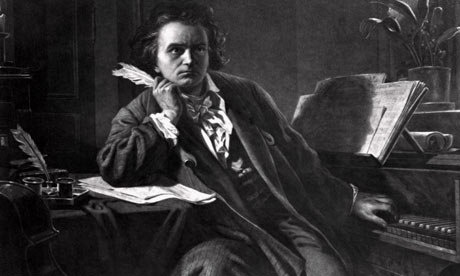So you open the door to the world's music room and before your eyes is a vast and endless hall which stretches out into eternity. For every song that has ever been created, there is a painting on the wall. Some paintings carry lyrics within them - others carry only musical instrumental images from which every viewer sees their own unique lyric. Every painting has the artist's signature in the bottom right corner.
Many - but not all - of the largest paintings have signatures stamped in the bottom corner bearing the mark of the musical factories and sweat shops of the last 60 years. Paintings which were created under the bull whip of men with their gaze fixed upon money, profit, and fame - who stifled and manipulated the artists who found themselves with "the man's" bit in their mouths and harnessed to his wagon as he whipped them on up the mountain of money. Faster, harder, faster, harder....radio tours, three cities a day....faster, harder, faster, harder. They funded your album, so now they own your soul. They hung a carrot made of fortune and fame on a stick in front of the team pulling their wagon. Hipsters, insiders, and outright thugs who couldn't sing or play a note, crafting the course of popular music in back room meetings to which the Spirit of creativity was not invited. The masses who unfortunately had never seen a painting by Rembrandt, Michelangelo, da Vinci, Monet, Dali, or Picasso, hailed many of these works of motel art as the works of genius.
However, as you walk down this endless hall, you are overwhelmed by the vast and unending display of small and obscure paintings - paintings which carry an entirely different vibe. These paintings convey true messages of life, of emotion, of pain, of joy, of struggle, of victory, of hope, of faith, of trials, of humor, of sadness, of love. You read the signatures of these paintings and find names the world never knew, or which have been forgotten. Many of these paintings have only been seen by a handful of people. You have to search out these paintings out as they are not displayed in the "art" galleries of the world's popular media, but rather are found in the obscure and hidden reaches where the Spirit of creativity seems to thrive. Small jazz clubs in NYC, front porches in Appalachia, tiny villages in Sudan, the pubs of Ireland, street corners in Argentina, kitchen tables in the Mississippi Delta, rock & roll bars in Dallas, the isolated practice rooms of the conservatories, the drums and voices of a church deep in the bush of Uganda, the projects of the inner cities, and the humble homes of the poets and minstrels all over the world. These paintings were painted by PEOPLE who were ALIVE, who faced CHALLENGES, who lived in a CULTURE, which had a MESSAGE, which HAD to be SPOKEN as it was BURNING in their SOULS.
As you walk down this endless hall of music, you find yourself passing over the large - sometimes gigantic - motel art paintings, and being drawn to the true works of ART which are most often very small - even tiny - paintings. You realize at last that in the world of music, SIZE DOESN'T MATTER, and you find yourself FREE to create songs which carry the message of your life, your culture, your soul and Spirit.













